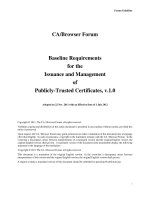AIS, interim guidelines for the presentation and display of ais target information
Bạn đang xem bản rút gọn của tài liệu. Xem và tải ngay bản đầy đủ của tài liệu tại đây (35.55 KB, 6 trang )
INTERNATIONAL MARITIME ORGANIZATION
4 ALBERT EMBANKMENT
LONDON SE1 7SR
Telephone: 020 7735 7611
Fax:
020 7587 3210
Telex:
23588 IMOLDN G
E
IMO
Ref. T2/2.07
SN/Circ.217
11 July 2001
INTERIM GUIDELINES FOR THE PRESENTATION AND
DISPLAY OF AIS TARGET INFORMATION
1
The Sub-Committee on Safety of Navigation (NAV), at its forty-seventh session (2 to 6 July 2001),
agreed on interim guidelines for the presentation and display of AIS target information.
2
The interim guidelines deal with the graphical presentation and display of AIS target data in
standalone or integrated navigational aids or systems and are considered as an interim performance
guideline. They should be replaced by the appropriate performance standards after experience has been
gained.
3
These interim guidelines have been established to allow manufacturers to develop the relevant
equipment and functions in time and to allow mariners to acquaint themselves with the use of intelligent
combination of information from the first date of AIS deployment.
4
Member Governments are invited to bring the annexed interim guidelines to the attention of all
concerned.
***
I:\CIRC\SN\217.doc
SN/Circ.217
ANNEX
INTERIM GUIDELINES FOR THE PRESENTATION AND
DISPLAY OF AIS TARGET INFORMATION
1
Definitions
Sleeping target
A target symbol indicating the presence and orientation of a vessel
equipped with AIS in a certain location. No additional information is
presented until activated thus avoiding information overload.
Activated target
A symbol representing the automatic or manual activation of a sleeping
target for the display of additional graphically presented information
including:
–
–
–
a vector (speed and course over ground);
the heading; and
ROT or direction of turn indication (if available) to display actually
initiated course changes.
Selected target
A symbol representing the manual selection of any AIS target for the
display of detailed information in a separate data display area. In this area,
received target data as well as the calculated CPA and TCPA values will
be shown.
Dangerous target
A symbol representing an AIS target (activated or not) which data
contravene pre-set CPA and/or TCPA limits.
Lost target
A symbol representing the last valid position of an AIS target before the
reception of its data was lost.
2
Operational requirements
In addition to the relevant performance standards, AIS information may be presented and displayed
according to the following interim guidelines.
2.1
Presentation of information
2.1.1 If AIS information is made available for a graphical display, at least the following information should
be displayed: (see resolution MSC.74(69), Annex 3 (AIS), paragraph 6):
.1
.2
.3
.4
.5
position;
course over ground;
speed over ground;
heading; and
rate of turn, or direction of turn, as available.
I:\CIRC\SN\217.doc
SN/Circ.217
ANNEX
Page 2
2.1.2 If information provided by AIS is graphically presented, the symbols described in the Appendix
should be applied. In the case of a radar display, radar signals should not be masked, obscured or
degraded.
2.1.3 Whenever the graphical display of AIS targets is enabled, the graphical properties of other target
vectors should be equivalent to those of the AIS target symbols, otherwise the type of vector presentation,
(radar plotting symbols or AIS symbols), may be selectable by the operator. The active display mode
should be indicated.
2.1.4 The presentation of AIS target symbols, except for sleeping or lost targets, should have priority over
other target presentations within the display area, including targets from EPA, ATA or ARPA. If such a
target is marked for data display, the existence of the other source of target data may be indicated, and the
related data may be available for display upon operator command.
2.1.5 The mariner should be able to select additional parts of the information from AIS targets, which
should then be presented in the data area of the display, including the ship’s identification, at least the
MMSI. If the received AIS information is not complete, this should be indicated.
2.1.6 A common reference should be used for the superimposition of AIS symbols with other information
on the same display, and for the calculation of target properties (e.g. TCPA, CPA.).
2.1.7 If AIS information is graphically displayed on a radar, the equipment should be capable of
appropriately stabilising the radar image and the AIS information.
2.1.8
Target data derived from radar and AIS should be clearly distinguishable as such.
2.1.9 The operator may choose to display all or any AIS targets for graphical presentation. The mode of
presentation should be indicated.
2.1.10 If the display of AIS symbols is enabled, removing a dangerous target should only be possible
temporarily as long as the operator activates the corresponding control.
2.1.11 The AIS symbol of an activated target may be replaced by a scaled ship symbol on a large
scale/small range display.
2.1.12 If the COG/SOG vector is shown, its reference point should be either the actual or the virtual
position of the antenna.
2.1.13 Means should be provided to select a target or own ship for the display of its AIS data on request.
If more than one target is selected, the relevant symbols and the corresponding data should be clearly
identified. The source of the data, e.g., AIS, radar, should be clearly indicated.
2.2
Processing of information
2.2.1 If zones or limits for automatic target acquisition are set, these should be the same for automatically
activating and presenting any targets regardless of their source.
I:\CIRC\SN\217.doc
SN/Circ.217
ANNEX
Page 3
2.2.2 The vector time set should be adjustable and valid for presentation of any target regardless of its
source.
2.2.3 If radar plotting aids are used for the display of AIS information, these should be capable of
calculating and displaying collision parameters equivalent to the available radar plotting functions.
2.2.4
If the calculated CPA and TCPA values of an AIS target are less than the set limits,
-
a dangerous target symbol should be displayed; and
an alarm should be given.
The preset CPA/TCPA limits applied to target data derived from different sensors should be identical.
2.2.5
If the signal of a dangerous AIS target is not received for a set time:
-
a lost target symbol should appear at the latest position and an alarm be given;
-
the lost target symbol should disappear after the alarm has been acknowledged; and
-
means to recover the data for a number of last acknowledged lost targets may be provided.
Preferably this function may also be applied to any AIS target within a certain distance.
2.2.6 An automatic display selection function may be provided to avoid the presentation of two target
symbols for the same physical target. If target data from AIS and from radar plotting functions are available,
then the activated AIS target symbol should be presented, if the automatic selection criteria is fulfilled,
otherwise the respective symbols should be displayed separately. The operator should have the option to
make reasonable changes to the default parameters of automatic selection criteria.
2.2.7 Means should be provided to display and acknowledge alarm messages from own AIS. Indication
should be given if own AIS is out of service or switched off.
2.3
Human Interface
As far as practical, the user interface for operating, displaying and indicating AIS functions should be
equivalent to the other relevant functions of the navigational aid.
I:\CIRC\SN\217.doc
SN/Circ.217
ANNEX
Page 4
Appendix
Recommended AIS Target Symbols
AIS target
Symbol
AIS target (sleeping)
Activated AIS target
Selected target
Dangerous target
Lost target
–
–
–
Description of symbol
An isosceles, acute-angled triangle should be used with its
centroid representing the target’s reference position. The
most acute apex of the triangle should be aligned with the
heading of the target, or with its COG, if heading
information is not available. The symbol of the sleeping
target may be smaller than that of the activated target.
An isosceles, acute-angled triangle should be used with its
centroid representing the target’s reference position. The
most acute apex of the triangle should be aligned with the
heading of the target, or with its COG, if heading
information is not available.
The COG/SOG vector should be displayed as dashed line
starting at the centroid of the triangle
The heading should be displayed as solid line of fixed length
starting at the apex of the triangle
A flag on the heading indicates a turn and its direction in
order to detect a target manoeuvre without delay
A path predictor may also be provided
A square indicated by its corners should be drawn around
the target symbol.
A bold line clearly distinguishable from the standard lines
should be used to draw the symbol. The size of the symbol
may be increased. The target should be displayed with:
vector, heading and rate of turn indication. The symbol
should flash until acknowledged.
The triangle should be red on colour displays.
A prominent solid line across the symbol, perpendicular to
the last orientation of the symbol should be used. The
symbol should flash until acknowledged. The target should
be displayed without vector, heading and rate of turn
indication.
If colour fill is used no other information should be masked or obscured.
Base stations may transmit information on targets tracked by other means. If these targets
are displayed they should be presented using symbols clearly distinguishable from the
symbols above.
Further symbology for special situations will be developed.
_______________
I:\CIRC\SN\217.doc









